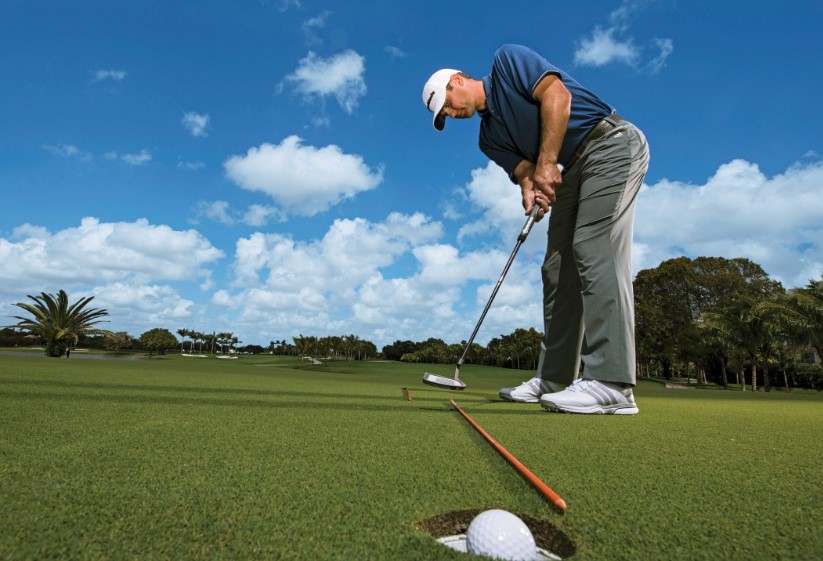Golf is a sport that relies on a combination of technique, strategy, focus, and the finesse of precise movements. Many players tend to focus solely on long shots—drives and approaches—when in fact, the success of a golfer often comes down to their short game, particularly putting. A small mistake during a putt can undo all the progress made from the tee box.
Although putting may seem simple at a glance, it demands a deep understanding of technique, discipline, and consistent practice to truly master. Unfortunately, not all golfers fully grasp the proper putting technique. This often leads to avoidable errors—putts that overshoot the hole or stop short due to insufficient strength. Understanding the correct putting strategies and techniques is essential for every golfer, from complete beginners to seasoned players. The following is a complete breakdown provided by GoGolf.
1. Pay Attention to Aim, Body Position, and Ball Placement
One of the most overlooked fundamentals in putting is paying attention to the ball’s rolling path, your body posture at address, and the placement of the ball before making a stroke. Unlike long shots where golfers often rely on a straight aim toward the target, putting requires more nuance. Greens have complex contours and slopes, and a misjudgment in alignment can easily send your ball off course.
Start by aligning your putter face accurately with the intended putting line. For right-handed players, your feet should be parallel and aligned slightly to the left of the hole. This setup promotes better balance and stability. Ensure the putter face is square to the target line and aligned with your stance. Your feet should be shoulder-width apart, pointing straight ahead, and the ball should be positioned slightly forward of the center of your stance.
This setup allows for a more natural pendulum-like swing. A common mistake is standing too far from the ball, which straightens and locks the elbows, making the stroke stiff and less controllable. Standing too close can also restrict movement and increase the risk of grounding the club. Try different stance distances to find your comfort zone. With proper posture and ball placement, you’ve already set yourself up for around 50% success in putting.
2. Keep Your Eyes Focused on the Ball
Putting success requires not just a technically sound swing but also precise coordination between your vision, body alignment, and club movement. One crucial putting tip is to lock your eyes on the ball. Many beginners make the mistake of shifting their gaze toward the hole too early, which lifts the head prematurely and ruins the strike.
Here’s a quick test: hold a second golf ball at eye level with your left eye and drop it. If it lands directly on the ball on the ground, your head and eyes are correctly positioned above the ball. This ensures a consistent gaze downward, promoting proper posture and alignment with your target line.
Maintaining eye focus on the ball even slightly after contact is essential for a stable stroke. Avoid the urge to immediately watch the ball roll. Trust your swing feel so that putter-ball contact happens cleanly and precisely.
[Read Also: How to Use the Putter Correctly in Golf]
3. Understand How to Grip the Putter Correctly
How you grip the putter has a major impact on the quality of your putting stroke. While long shots like drives or irons involve flexible wrist movement to generate power, putting demands the opposite—a firm, steady wrist for better directional control.
The putting grip isn’t radically different from other clubs, but it requires a more neutral hand position. The right index finger should slightly extend down the shaft below the grip, while the left index finger rests atop the fingers of the right hand. This grip ensures both hands work together as a unit, minimizing the risk of wrist breakdown that can twist the putter face during impact.
Avoid gripping the putter too tightly, which can cause muscle tension and reduce fluidity. However, gripping it too loosely can make the club unstable and affect direction. Aim for a grip that is firm yet relaxed—secure enough for control, but flexible enough for a smooth stroke.

4. Push the Ball with a Smooth Motion, Don’t Hit It
One of the most common putting mistakes is treating the stroke like a full swing—thinking you have to “hit” the ball. In reality, putting is all about gently pushing the ball with a short, controlled stroke. The motion should be driven by your shoulders, with wrists remaining quiet throughout the stroke.
During the stroke, make sure your hips and lower body remain still. Your weight should be evenly distributed—50/50 between both feet—to ensure balance. The backswing and follow-through should be of equal length, with stroke speed being the only variable depending on the distance of the putt.
Also, use your palms to gently guide the putter rather than flicking with your wrists. Keep the putter face square to the target line throughout the stroke. This will ensure that the ball rolls smoothly and stays on the intended path without veering left or right.
5. Warm Up Before Putting to Develop Feel and Control
Before starting your actual round, it’s highly recommended to warm up with putting drills—swing the putter back and forth several times while visualizing your target line. This routine helps relax your muscles while also developing the mental and physical feel of stroke length and required force.
Repeat this motion until you feel comfortable and confident in both power and direction. If possible, warm up on a practice green before your round to get a sense of the speed and condition of the greens that day.
Conclusion: Putting is the Art of Controlling Power and Precision
Among all the shots in golf, putting is arguably the most mentally and technically demanding. A perfect drive or iron shot can be rendered meaningless if you miss an easy putt. That’s why mastering putting technique—starting from address position, eye focus, grip, stroke mechanics, and feel training—is absolutely essential.
By applying the correct putting fundamentals, you’ll be able to execute a stable, accurate, and confident putting stroke. You’ll also avoid common mistakes like hitting too softly or overshooting the hole. Remember, putting is not about power—it’s about precision and control.
As you continue to practice and gain experience, putting will likely become the shot you enjoy the most in golf. It challenges your mind while delivering a unique satisfaction when the ball drops cleanly into the cup. Keep practicing and embrace every step of the journey, because that’s where the true beauty of golf lies.
[ Follow our social media Account: GoGolf Instagram | GoGolf Facebook | GoGolf X ]











